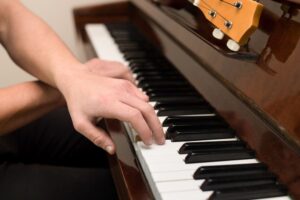This article details 3 different tips to improve sight-reading for beginning through intermediate piano students. These ideas can help in building fluency with new pieces at a quicker rate, and can help with overall note-reading comprehension.

As most students and teachers know, sight reading and overall note-reading ability is a crucial part of piano study. Also, it is a process that must be done every time a new piece of music is put in front of you, as sight-reading is literally the “playing through” of a piece for the first time. There are various tips and tricks available for sight reading practice, but detailed below are my top 3. Remember, these tips can also help with overall note reading ability and should be considered not just for the first run through, but the first several attempts at a new piece.
Don’t look at your hands!
Way easier said than done, right? That’s totally normal. Most pianists find it to be a struggle in early study, because it’s a basic instinct. We can easily get distracted trying to refine our movements to a point where it seems nearly impossible to look down and check out what’s going on. Also, there can be a big connection with seeing and verifying that the note you are playing matches what is on the page.
So how do we overcome this challenge? To me, it’s just a strength of will. Often times, we underestimate how valuable concentrating on something like “not looking at your hands” is. When you are actively thinking about correcting a technique you know is incorrect, that means you are giving yourself a constant reminder. It doesn’t mean that you won’t look down occasionally—you probably will. But, the more you think about avoiding it, the more it gets corrected and becomes a good habit.
In sight-reading, you have to have full focus on the musical notation (or notes) in front of you. Therefore, giving yourself the “don’t look at your hands” reminder helps tremendously in reading more and more complex musical examples. In addition, practicing this technique gives you an advantage in gaining the tactile memory of the piano.
Imagine “The Bouncing Ball”
I love this technique to improve sight reading! In old T.V. singalongs, there used to be a bouncing ball that pointed to every word when it was time to sing it with the music. If you have no context for the “bouncing ball” and what it looks like, use an example like imagining someone pointing to every written word of a song as you sing. Well, with note-reading, you can apply the same idea. Imagine the bouncing ball or a pointer following every note you play. The goal is to keep your eye on the pointer for the next note coming up.
What does this accomplish? You’ll be looking for the next note the entire time you are playing, as you will be essentially pointing to each note with your eyes. This level of concentration is what sight reading requires because everything is unfamiliar and new at that point. In looking at the music the whole time, you have a great advantage starting out. And where else could you be looking that isn’t helpful? Your hands!
Keep A Constant Count
Before you begin your first attempt at a new song, set a steady beat. How fast you set the steady beat is the most crucial point. Maybe you’ve heard the piece you are about to play before, and you already have in mind what that steady beat should be when the piece is finished. This is not the tempo (or speed) for you starting out. In fact, there are several different speeds you set as you learn a piece that progressively get faster.
Start slow. You can do a quick scan through the piece to get an idea of how difficult it will be to determine how slow. I like to have my students also count out what speed they are going to start the song so I can give an initial “yes, that’s good,” or “no, that’s a bit too fast” bit of feedback beforehand.
And keep counting. Don’t lose the steady beat as you play, and if you miss a note on the first run-through, it’s really not a big deal. In sight-reading, you are getting an idea of how the piece will sound, so don’t get hung up on the little mistakes. Those will be worked on after the run-through, so let the counting keep you moving.
Improve Piano Sight Reading
Becoming a proficient sight reader is a huge component of piano study, but it doesn’t have to be the most difficult process either. It’s just a new piece, and the idea of sight-reading is to give a good overview of where the areas of difficulty lie. There are literally hundreds of tips that apply to sight reading, but I’ve seen my top 3 provide excellent results. So, stay focused, take it slow, and your sight-reading practice can be a huge success!
Lessons in Your Home is designed around doing everything in your home. Our teachers will come right to your home for every lesson, plus we offer virtual music lessons, too. However, our online music lessons are being taught by local music teachers with live lessons tailored to your child! Contact us today to learn more.